Engine Oldsmobile Alero 2003 s Manual Online
[x] Cancel search | Manufacturer: OLDSMOBILE, Model Year: 2003, Model line: Alero, Model: Oldsmobile Alero 2003Pages: 354, PDF Size: 16.74 MB
Page 277 of 354

Changing a Flat Tire
If a tire goes flat, avoid further tire and wheel damage
by driving slowly to a level place. Turn on your
hazard warning flashers.
Changing a tire can cause an injury. The
vehicle can slip
off the jack and roll over you
or other people. You and they could be badly
injured. Find a level place to change your tire.
To help prevent the vehicle from moving:
1. Set the parking brake firmly.
2. Put an automatic transaxle shift lever in
PARK (P), or shift a manual transaxle to
FIRST
(1) or REVERSE (R).
3. Turn off the engine.
To be even more certain the vehicle won't
move, you can put blocks at the front and
rear
of the tire farthest away from the one
being changed. That would be the tire on
the other side
of the vehicle, at the
opposite end. The following
steps will tell you how to use the jack and
change a tire.
5-62
Page 295 of 354
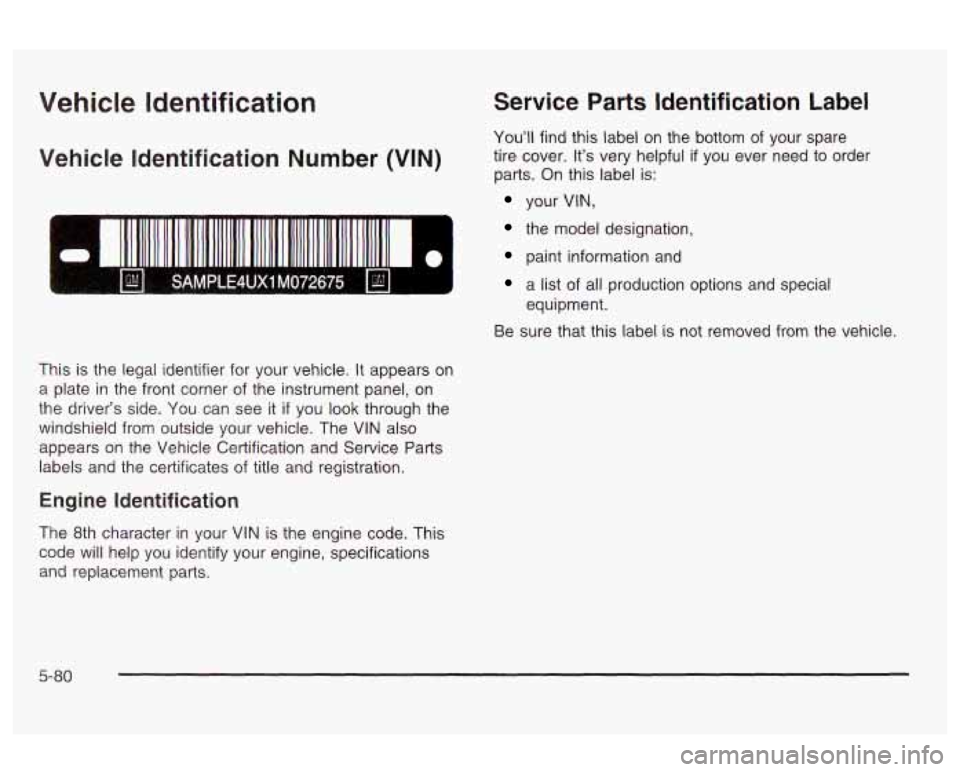
Vehicle Identification
Vehicle Identification Number (VIN)
0 I
Service Parts Identification Label
You’ll find this label on the bottom of your spare
tire cover. It’s very helpful
if you ever need to order
parts. On this label
is:
your VIN,
the model designation,
paint information and
a list of all production options and special
equipment.
Be sure that this label is not removed from the vehicle.
This is the legal identifier for your vehicle.
It appears on
a plate in the front corner of the instrument panel, on
the driver‘s side. You can see it
if you look through the
windshield from outside your vehicle. The VIN also
appears on the Vehicle Certification and Service Parts
labels and the certificates of title and registration.
Engine Identification
The 8th character in your VIN is the engine code. This
code will help you identify your engine, specifications
and replacement parts.
5-80
Page 296 of 354
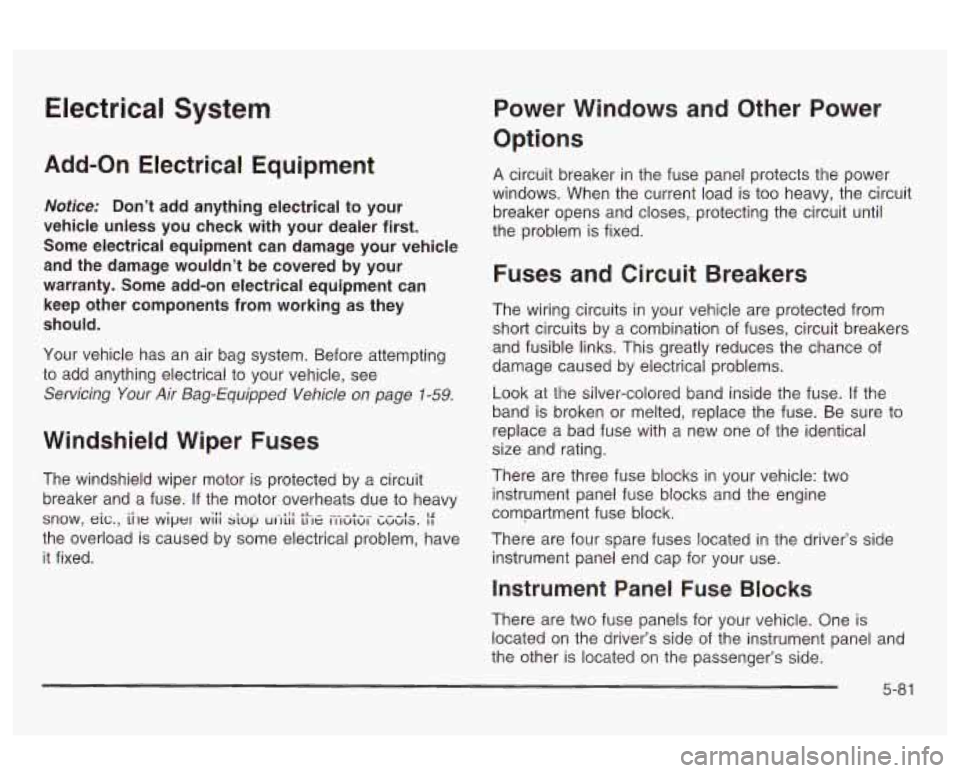
Electrical System
Add-On Electrical Equipment
Notice: Don’t add anything electrical to your
vehicle unless you check with your dealer first.
Some electrical equipment can damage your vehicle
and the damage wouldn’t be covered by your
warranty. Some add-on electrical equipment can
keep other components from working as they
should.
Your vehicle has an air bag system. Before attempting
to add anything electrical to your vehicle, see
Servicing Your Air Bag-Equipped Vehicle on page 1-59.
Windshield Wiper Fuses
The windshield wiper motor is protected by a circuit
breaker and a fuse. If the motor overheats due to heavy
the overload is caused by some electrical problem, have
it fixed. snow,
eic., iile wiper wiii siup ui-liii ti-le i-hstci- GS~S. If
Power Windows and Other Power
Options
A circuit breaker in the fuse panel protects the power
windows. When the current load is too heavy, the circuit
breaker opens and closes, protecting the circuit until
the problem is fixed.
Fuses and Circuit Breakers
The wiring circuits in your vehicle are protected from
short circuits by a combination
of fuses, circuit breakers
and fusible links. This greatly reduces the chance of
damage caused by electrical problems.
There are three fuse blocks in your vehicle: two
instrument panel fuse blocks and the engine
compartment fuse block.
There are four spare fuses located in the driver’s side
instrument panel end cap for your use.
Instrument Panel Fuse Blocks
There are two fuse panels for your vehicle. One is
located on the driver’s side of the instrument panel and
the other is located on the passenger’s side.
5-81
Page 299 of 354

Engine Compartment Fuse Block
The engine compartment fuse block is located on the
driver’s side of the engine compartment, near the
battery. Fuse 1
2
3
4
5
6
7
8
Relays
9
10
11
12
13
14
15
Usage
Ignition Switch
Right Electrical Center-Fog Lamps,
Radio, Body Function Control
Module, Interior Lamps
Left Electrical Center-Stop Lamps,
Hazard Lamps, Body Function
Control Module, Cluster, Climate
Control System
Anti-Lock Brakes
Left Electrical Center-Power Seats,
Power Mirrors, Door Locks, Trunk
Release, Audio Amplifier, Remote
Keyless Entry
Not Used
Ignition Switch
Cooling Fan
#I
Usage
Rear Defog
Not Used
Starter
Cooling Fan
#1
HVAC Blower (Climate Control)
Cooling Fan
#2
Cooling Fan
5-84
Page 301 of 354
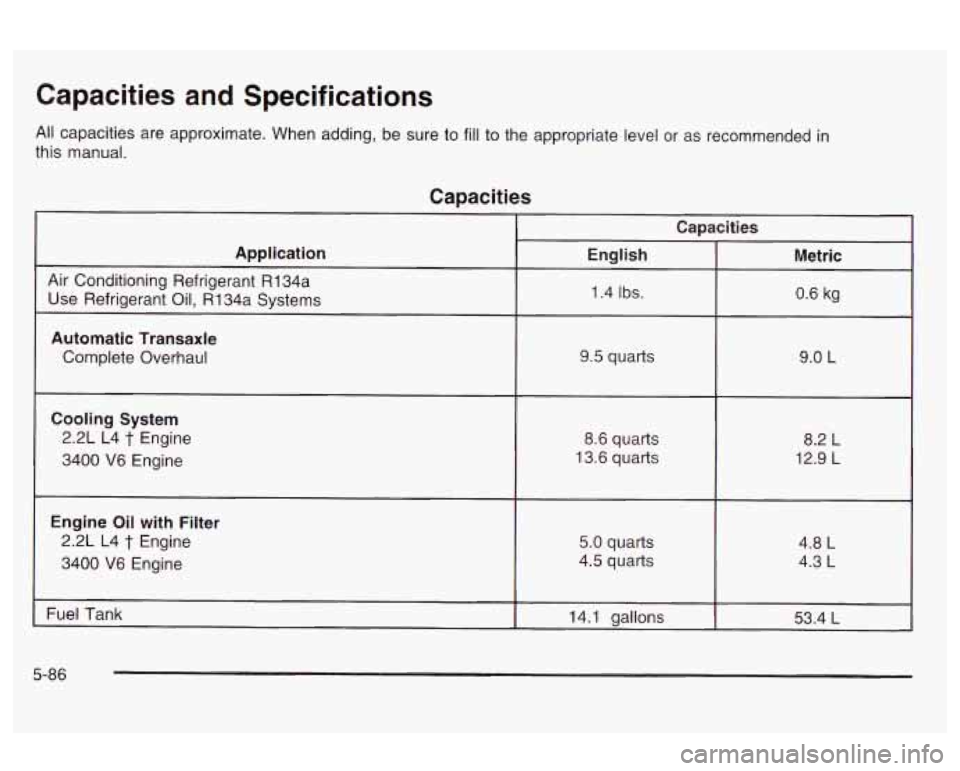
Capacities and Specifications
Capacities
Automatic Transaxle
Complete Overhaul
Cooling System
2.2L L4
t Engine
3400 V6 Engine
Engine Oil with Filter
2.2L L4
t Engine
3400 V6 Engine 8.6
quarts
13.6 quarts 8.2
L
12.9 L 5.0 quarts
4.5 quarts 4.8
L
4.3 L
5-86
Page 302 of 354
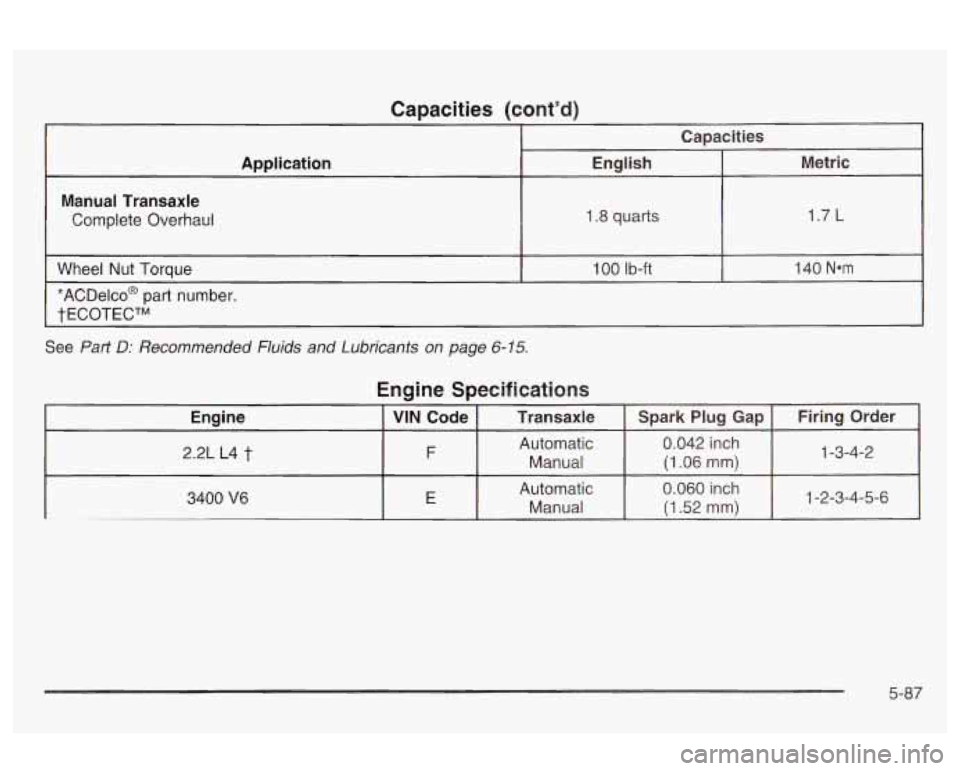
Capacities (cont’d)
Manual Transaxle Complete Overhaul 1.8
quarts 1.7
L
I
Wheel Nut Torque
*ACDelco@ part number. 1
00 Ib-ft
tECOTECTM I 140 Nom
See Part D: Recommended Fluids and Lubricants on page 6-15.
Engine Specidicatians
I
3400 V6 E Automatic 0.060 inch
Manual
(1.52 mm) 1-2-3-4-5-6
5-87
Page 303 of 354
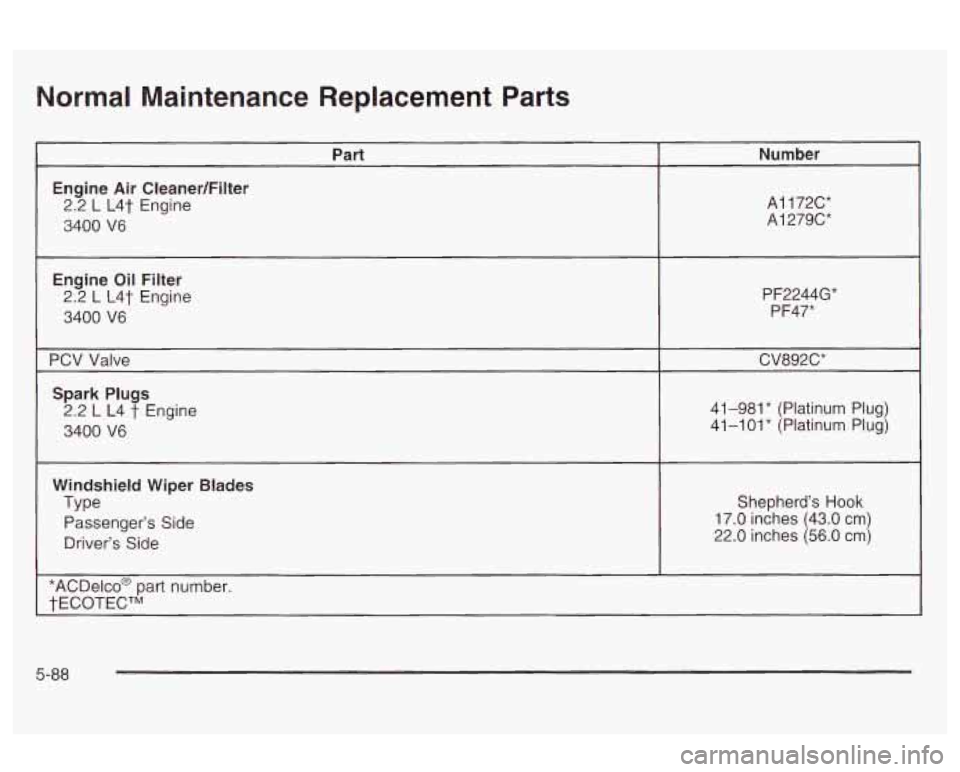
Normal Maintenance Replacement Parts
Part I
Engine Air Cleaner/Filter
2.2 L L4t Engine
3400 V6 Number
AI 172C*
AI 279C"
Engine Oil Filter
2.2
L L4t Engine
3400 V6
PCV Valve Spark Plugs 2.2
L L4 t Engine
3400 V6 PF2244G*
PF47*
CV892C*
41-981
* (Platinum Plug)
41-1
01 * (Platinum Plug)
Windshield Wiper Blades
TY Pe
Passenger's Side
Driver's Side
*ACDelco@
part number.
tECOTECTM Shepherd's
Hook
17.0 inches
(43.0 cm)
22.0 inches (56.0 cm)
5-88
Page 304 of 354
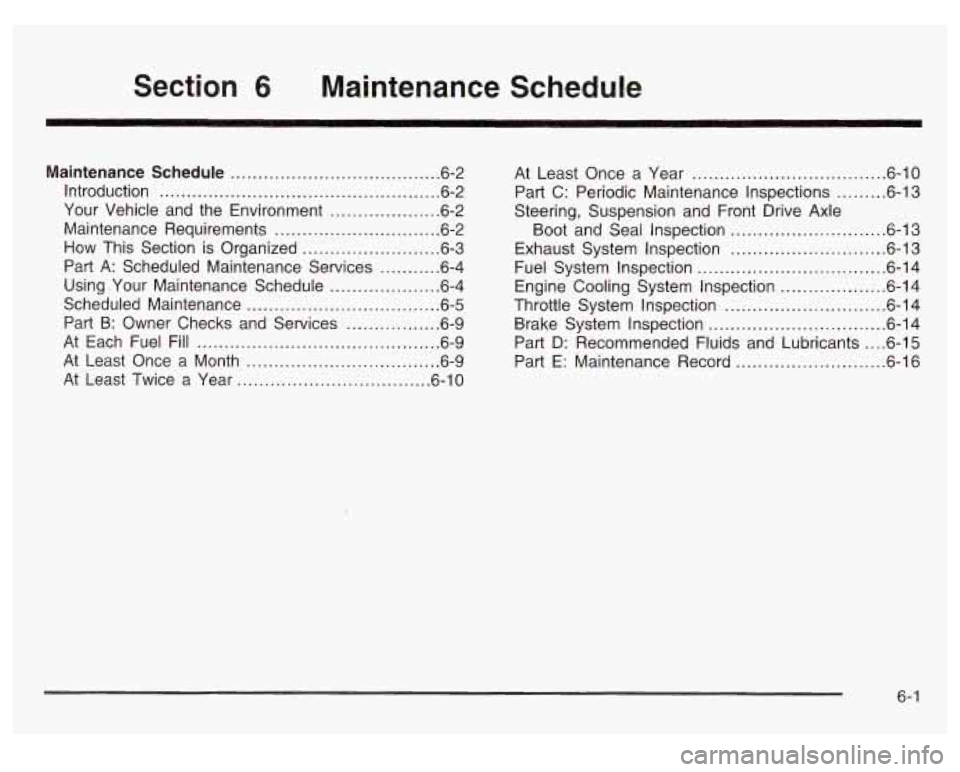
Section 6 Maintenance Schedule
Maintenance Schedule ...................................... 6.2
Introduction
................................................... 6.2
Your Vehicle and the Environment
.................... 6-2
Maintenance Requirements
.............................. 6-2
How This Section
is Organized ......................... 6-3
Part A: Scheduled Maintenance Services
........... 6-4
Using Your Maintenance Schedule
.................... 6-4
Scheduled Maintenance
................................... 6-5
Part B: Owner Checks and Services
................. 6-9
At Each Fuel Fill ............................................ 6-9
At Least Once a Month ................................... 6-9
At Least Twice a Year ................................... 6-10 At
Least Once a Year
................................... 6.10
Part C: Periodic Maintenance inspections
......... 6.13
Steering, Suspension and Front Drive Axle
Boot and Seal inspection
............................ 6.13
Exhaust System Inspection
............................ 6.13
Fuel System Inspection
.................................. 6.14
Engine Cooling System Inspection
................... 6.14
Throttle System Inspection
............................. 6.14
Brake System inspection
................................ 6.14
Part D: Recommended Fluids and Lubricants
.... 6-15
Part E: Maintenance Record
........................... 6.16
6- 1
Page 305 of 354
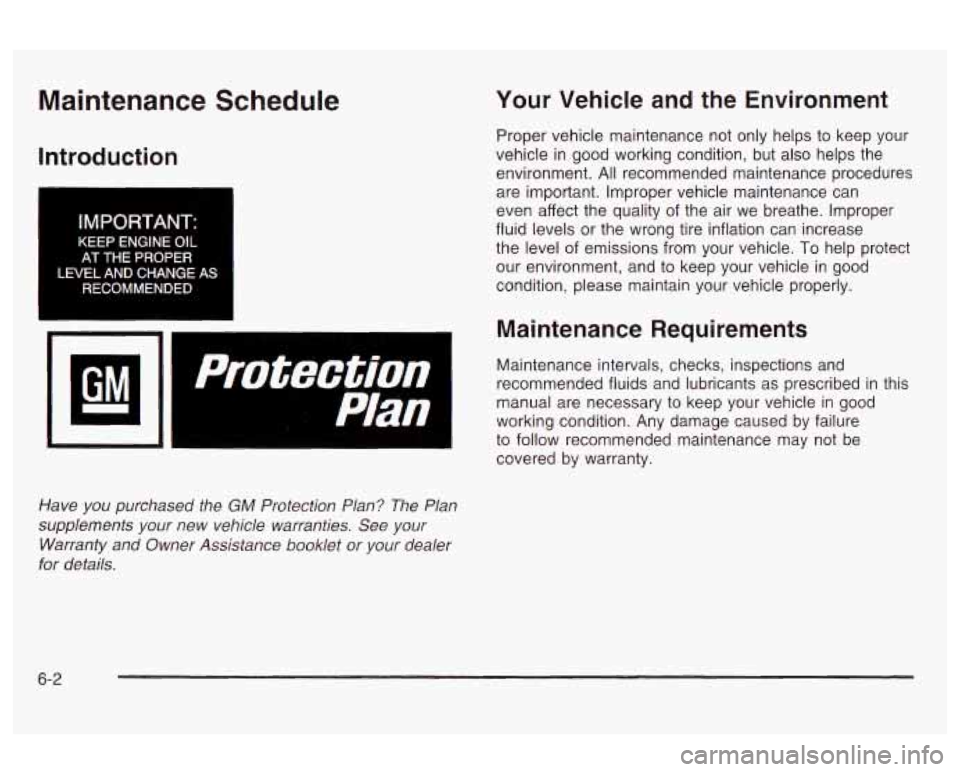
Maintenance Schedule
Introduction
IMPORTANT:
KEEP ENGINE OIL AT THE PROPER
LEVEL AND CHANGE AS RECOMMENDED
14
r
Have you purchased the GM Protection Plan? The Plan
supplements your new vehicle warranties. See your
Warranty and Owner Assistance booklet or your dealer
for details.
Your Vehicle and the Environment
Proper vehicle maintenance not only helps to keep your
vehicle in good working condition, but also helps the
environment. All recommended maintenance procedures
are important. Improper vehicle maintenance can
even affect the quality
of the air we breathe. Improper
fluid levels or the wrong tire inflation can increase
the level of emissions from your vehicle.
To help protect
our environment, and to keep your vehicle in good
condition, please maintain your vehicle properly.
Maintenance Requirements
Maintenance intervals, checks, inspections and
recommended fluids and lubricants as prescribed in this
manual are necessary to keep your vehicle in good
working condition. Any damage caused by failure
to follow recommended maintenance may not be
covered by warranty.
6-2
Page 307 of 354

Part A: Scheduled Maintenance
Services
This part contains engine oil scheduled maintenance
which explains the engine oil life system and how
it indicates when to change the engine
oil and filter.
Also, listed are scheduled maintenance services which
are
to be performed at the mileage intervals specified.
Using Your Maintenance Schedule
We at General Motors want to keep your vehicle in good
working condition. But we don’t know exactly how
you’ll drive it. You may drive short distances only a few
times
a week. Or you may drive long distances all
the time in very hot, dusty weather. You may use your
vehicle in making deliveries. Or you may drive it to
work, to
do errands or in many other ways.
Because of the different ways people use their vehicles,
maintenance needs may vary. You may need more
frequent checks and replacements.
So please read the
following and note how you drive.
If you have
questions on how to keep your vehicle in good condition,
see your dealer. This part tells
you the maintenance services you should
have done and when you should schedule them.
When you go to your dealer for your service needs,
you’ll know that GM-trained and supported service
people will perform the work using genuine GM parts.
The proper fluids and lubricants to use are listed in
Part
D. Make sure whoever services your vehicle uses
these.
All parts should be replaced and all necessary
repairs done before you or anyone else drives the
vehicle.
This schedule is for vehicles that:
carry passengers and cargo within recommended
limits. You will find these on your vehicle’s
Tire-Loading Information label. See
Loading Your
Vehicle on page 4-34.
are driven on reasonable road surfaces within legal
driving limits.
use the recommended fuel. See Gasoline Octane
on page 5-5.
6-4